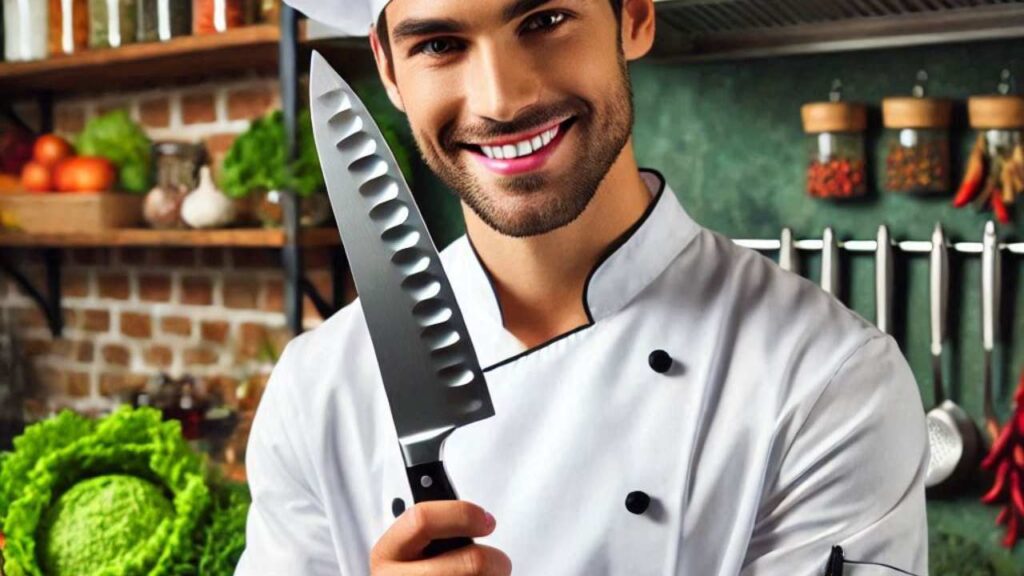When it comes to preparing food, a sharp and durable chef’s knife is one of the most important tools in the kitchen. It not only makes cutting easier but also ensures precision, speed, and safety. But why are chefs knives so sharp? The secret lies in their design, materials, and craftsmanship.
In this blog post, we will uncover 7 fascinating facts that explain the sharpness and durability of chef’s knives. By understanding these details, you’ll gain insight into why they’re a must-have in every kitchen.
Why Are Chefs Knives So Sharp? 7 Key Facts

1. High-Quality Blade Materials
The materials used to make chef’s knives are a primary reason they are so sharp and durable. Most chef’s knives are crafted from high-carbon stainless steel, which offers a perfect balance between sharpness and resistance to rust or corrosion.
- Benefits of sharp chef’s knives: High-carbon steel holds an edge for longer, meaning less frequent sharpening.
- Why are chef’s knives so sharp? The combination of carbon and stainless steel ensures that the blade retains its sharpness even after extended use.
2. Precision Craftsmanship
Craftsmanship is another crucial factor behind the sharpness of chef’s knives. These knives are meticulously forged and finished by skilled artisans who ensure every blade meets exacting standards.
- Blades are often hand-forged to achieve perfect sharpness.
- How do chef’s knives stay sharp? The grinding and polishing process creates a fine edge that stays razor-sharp for longer periods.
3. Fine Blade Angle
The sharpness of a chef’s knife is also attributed to its blade angle. Chef’s knives typically have a thinner edge angle, ranging between 15 to 20 degrees per side. This design creates an ultra-sharp edge.
- What makes chef’s knives different? The lower angle results in a finer cutting edge compared to standard kitchen knives.
- This precision blade angle makes them ideal for slicing, dicing, and chopping with ease.
4. Durable Full-Tang Design
Chef’s knives are designed to last. Their full-tang construction—where the blade extends through the handle—provides strength, balance, and durability.
- The full-tang design ensures that the knife can handle heavy-duty tasks without breaking.
- Benefits of sharp chef’s knives: They remain stable during use, reducing the risk of accidents or blade chipping.
5. Advanced Heat Treatment Process
Heat treatment is a critical step in the manufacturing of chef’s knives. The blade is heated and cooled in a controlled manner to enhance its hardness and durability.
- This process allows the blade to hold its sharp edge for a longer time.
- Proper heat treatment ensures the steel is tough yet flexible, making it resistant to wear and tear.
6. Versatile Blade Shape
Chef’s knives are designed to handle a wide variety of tasks, from chopping vegetables to slicing meat. Their versatility requires an exceptionally sharp blade.
- The curved edge allows for efficient rocking motions during chopping.
- Why are chef’s knives so sharp? Their multi-purpose design ensures they excel at various kitchen tasks without compromising performance.
7. Regular Maintenance Keeps Them Sharp
Finally, proper care and maintenance are essential to maintaining the sharpness of a chef’s knife. Regular honing and occasional sharpening help retain the blade’s edge.
- How do chef’s knives stay sharp? Using a honing rod realigns the blade’s edge, while sharpening stones restore its sharpness.
- Cleaning the knife by hand and storing it properly also prevent unnecessary dulling.
Chef’s Knives vs Standard Kitchen Knives
| Feature | Chef’s Knife | Standard Kitchen Knife |
|---|---|---|
| Blade Material | High-carbon stainless steel | Basic stainless steel |
| Edge Angle | 15-20 degrees | 20-25 degrees |
| Durability | Highly durable | Moderate durability |
| Sharpness Retention | Excellent | Moderate |
| Versatility | Multi-purpose | Limited |
Tips for Maintaining a Sharp Chef’s Knife

- Hone Regularly: Use a honing rod after every few uses to realign the blade’s edge.
- Sharpen When Necessary: Use a sharpening stone or professional sharpening service to restore the blade’s sharpness when needed.
- Wash by Hand: Avoid putting the knife in the dishwasher, as it can dull the blade.
- Store Properly: Use a knife block, magnetic strip, or blade guard to protect the edge from damage.
- Use the Right Cutting Surface: Wooden or plastic cutting boards are gentler on the blade than harder surfaces like glass or stone.
Related Article: 9 Things You Should Know Before Cutting Meat with a Chef Knife
Conclusion
Chef’s knives are sharp and durable for a reason. From high-quality materials to expert craftsmanship, every aspect of their design is focused on delivering exceptional performance. Understanding why are chefs knives so sharp not only helps you appreciate these tools but also emphasizes the importance of proper care to maintain their sharpness.
Whether you’re a home cook or a professional chef, investing in a quality chef’s knife and following the right maintenance practices can elevate your cooking experience.
FAQ’s
Why are chef’s knives so sharp compared to regular knives?
Chef’s knives are made from high-carbon stainless steel and feature a finer blade angle, making them sharper and more durable than standard knives.
How do chef’s knives stay sharp for a long time?
Their high-quality materials, precise craftsmanship, and proper heat treatment ensure that chef’s knives retain their edge for extended periods.
What makes chef’s knives different from other kitchen knives?
Chef’s knives are versatile, durable, and designed with a sharp edge angle, making them suitable for a wide range of tasks.
What are the benefits of sharp chef’s knives?
Sharp chef’s knives improve precision, reduce effort, and enhance safety by requiring less force during cutting.
How should I care for a chef’s knife to keep it sharp?
Regular honing, occasional sharpening, handwashing, and proper storage are essential for maintaining a chef’s knife’s sharpness and longevity.


One thought on “7 Facts That Explain Why Chef’s Knives Are So Sharp and Durable”